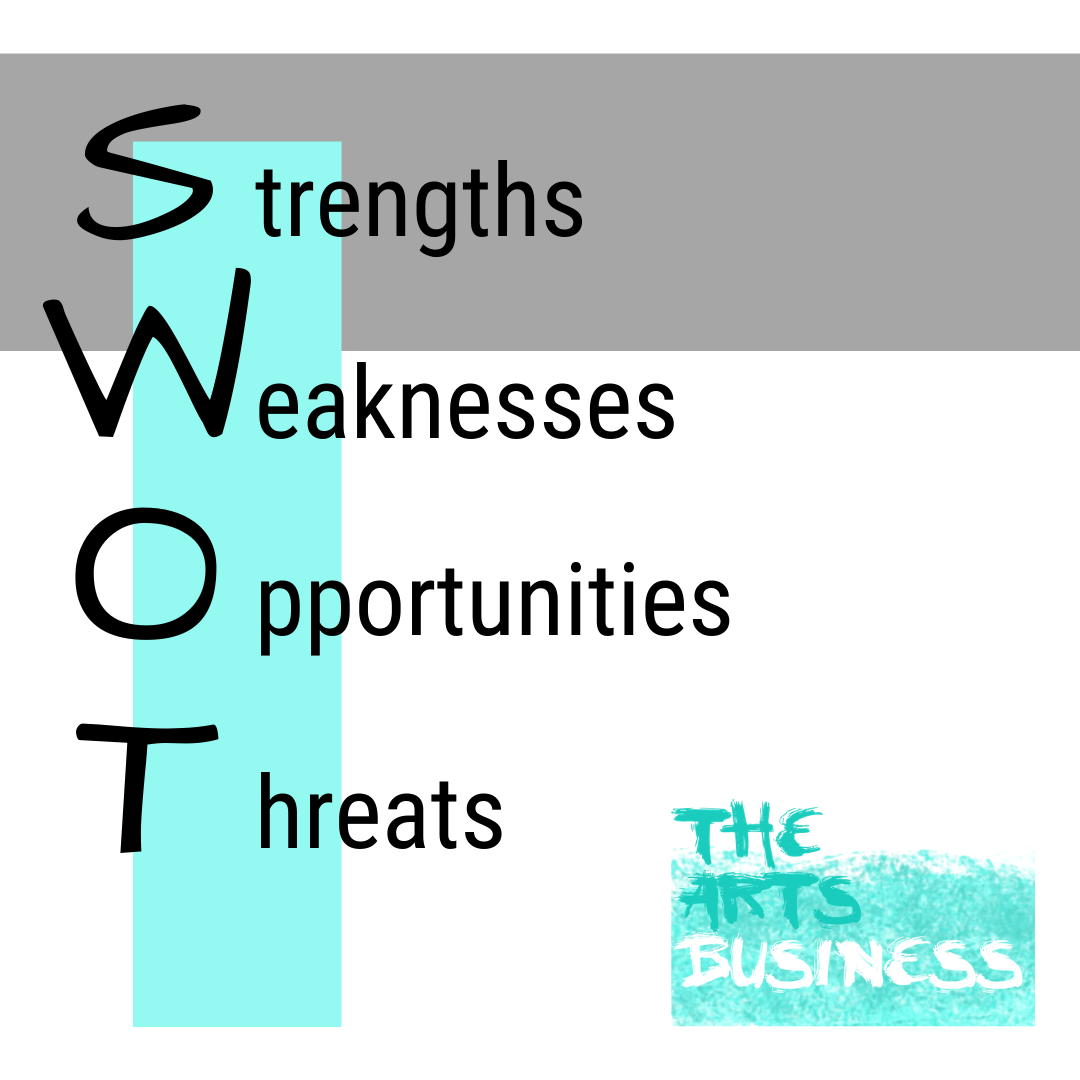How to Perform a SWOT Analysis on your Arts Business
As a second lockdown looms and we are all wondering what is in store for the creative industries it’d be easy to hunker down and get back to our main mission of 2020: trying to complete Netflix.
But don’t rest on your laurels!
Use this time as a chance to analyse your business and create a plan for the future.
The easiest way to do this is to create a SWOT analysis for your arts business. Now, I’m sure many of you have heard this term before but haven’t necessarily put it in place for your business.
Simply put, SWOT stands for:

When creating your SWOT analysis just take it section by section and ask yourself the following questions:
STRENGTHS
- How strong is your product or service?
- Whether you’re a theatre company creating a show or a gallery retailing prints it is important to look closely at what you are selling.
- What is your Unique Selling Point (USP)?
- What makes you stand out from the crowd? Are you a musician that can play the drums and electric guitar at the same time? That would be your USP.
- What makes your company stand out from your competitors?
- Perhaps you’re a wedding photographer, what makes you different from all the other wedding photographers out there? Are you an airbrush expert? A master at taking action shots? That is most definitely a strength.
- What business areas and departments are your best?
- If you’re a performer you might be amazing at coming up with social media content for your marketing, or great at sales! Think about all the different departments of a traditional business and which ones you ace.
- What assets does your business own?
- Take an up and coming arts centre, a key asset might be an office and multipurpose arts space in a bohemian suburb of a city. That would be a mega-strength!
WEAKNESSES
- What are the weaknesses in your products or services?
- Be objective here, where does your arts company fall short or where could you see room to improve.
- What is your brand lacking?
- For example, are you up to date with all the latest technologies? If you’re a comedian, you could be well suited to Tik-Tok so if don’t yet have an account this could be a weakness.
- In what areas are you vulnerable to your competition?
- If you’re a new business you might lack the staff base that your competition has, this could be a vulnerability.
- What business areas and departments are your weakest?
- I know here at the Arts Business our weakest department is our accounts! But we have transformed this into an opportunity enrolling in numerous online courses in bookkeeping to improve.
- What assets are you lacking?
- This could be anything from lacking external office space to having a limited following on social media. Take these in your stride and create business goals around them.
You can then use these answers to help you establish your Opportunities and Threats.
OPPORTUNITIES
- Where could you make improvements in your company?
- Can you build upon your weaknesses?
- Can you turn your problems into opportunities?
THREATS
- Are there barriers or obstacles which may affect you entering your chosen creative industry?
- Are there external factors (for example a tumultuous government or a global pandemic) that may cause problems in your chosen market?
We all know, as artists, it can be a struggle to brag about what we’re good at and admit to our shortfalls which is exactly what can make performing a SWOT analysis tricky. The difficulty comes in looking objectively at these aspects of your business.
There are a few things you can do to get into the swing of it:
- Start by performing SWOT analysis on your competition! It is easier to nit-pick at a company that isn’t yours, and once you have discovered their strengths and weaknesses you will find it much simpler to spot your own. Also, you might even find a gap in the industry which your company could fill.
- Have a friend or colleague perform a SWOT analysis of your business. Bringing in external opinions or utilising your staff who see your company from a different perspective can be a great way to reveal strengths and weaknesses you may have otherwise been unaware of.
- Get in a consultant to do it for you (like the Arts Business). If you’ve got the money this can be a great way to spend it as an external consultant is much more likely to be impartial when analysing your company.
This will enable you to successfully construct a plan of what you can do to improve and how the things you are already awesome at can help you to become even more awesome!
REMEMBER: If 2020 has proved anything to us it is that the world is always changing and we need to be ready to adapt and evolve with it.
So, don’t just do a SWOT Analysis once! Think of it more like a cycle to enable constant growth and development.
Have you done a SWOT analysis on your Arts Business? We would love to include it in this post as an example! Let us know in the comments below or contact us.

